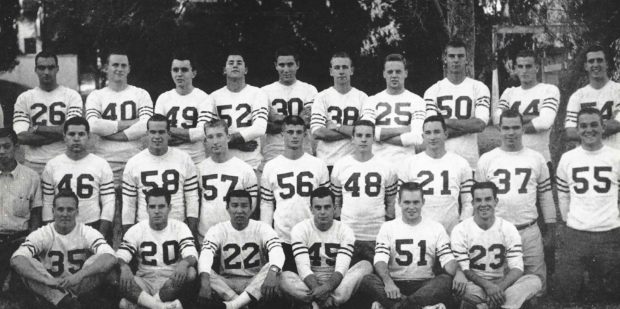
In this photo of the 1958 freshman football team, the author is number 30 in the center of the back row.
Some dates and events are indelibly imprinted in our memories. The obvious ones are typically the saddest—such as Pearl Harbor Day, the day President Kennedy was assassinated and the day the World Trade Towers were leveled. We remember where we were, who we were with and what we were doing when we received the news.
Halloween 1958 was not nearly as momentous and was far less significant to our national history. But it is still a date I’ll never forget.
Sixty-plus years ago, I was a freshman at Pomona College and (barely) on the freshman football team. In those days, freshmen had their own schedule and could not play on the varsity team. Not that I could ever have made the varsity football team and surely not as a freshman.
I chose Pomona in part because I thought of myself as a football star even though I never played in high school and could never have made the state championship team at my 3,500-student high school. Division III was for me.
What funny games the mind can play.
When I arrived at Pomona, I went out for football. The coaches needed cannon fodder for practice, so I was allowed to practice and then to suit up for real games. We played a schedule of seven games. I think I played in three of them.
I recall having a really good game against Caltech—participating in maybe 10 plays in which I made a number of unassisted tackles and a few quarterback sacks.
In those days college football players played both offense and defense. Fuzz Merritt was coaching at Pomona and insisted on using the single wing, which was in style when he had played for Pomona in the 1920s. It was decidedly not in style in 1958. Only Princeton, UCLA and Tennessee and perhaps a few other schools were still using the throwback single wing.
There are four backs in a single wing offense: a tailback who runs and throws the ball after receiving a direct snap from center, a quarterback who calls signals and sometime takes a direct snap from center, a fullback who blocks up the middle and a wingback who takes reverses and catches passes, among other things. The linemen often pull to block for the backs on power plays over tackle and around the end.
I played right guard on offense and nose guard on defense. I weighed 175 pounds. We all were small.
One of the teams on our schedule was San Diego State, which then was at the nadir of its football prowess. (Pomona would no more think of scheduling San Diego State for a football game today than scheduling UCLA.) We played San Diego State on Oct. 31, 1958, in the old, old Aztec Stadium on the San Diego campus.
We boarded a bus in Claremont in the early morning—all 25 of us—and headed south on Highway 101 to San Diego. We had a picnic lunch at a rest stop along the highway and arrived at Aztec Stadium around noon. There was no locker room for us. We changed clothes in a big room with bales of hay spread on the floor.
When we took the field, we could see the Aztecs were a lot bigger than we were. The person across the line from me was a giant. I estimate that he weighed 220 pounds, which would make him a running back today. But because we ran the single wing, which no one knew how to defend, and because our linemen typically blocked at an angle while running, we did all right.
We pushed San Diego State up and down the field but could not penetrate their 20-yard line. They couldn’t penetrate our 20-yard line either, until late in the game when our center hiked the ball over our tailback’s head and some 220-pound Aztec (probably my man) tackled our tailback in the end zone for a safety. That was the only score of the game: San Diego State Freshmen 2, Pomona College Freshmen 0.
We were solemn as we boarded the bus for the trip back to Pomona College. Our line coach, Ben Hines (for whom the baseball field at La Verne University is named), kept shaking his head and saying: “2–0. I can’t believe it. That is a baseball score, not a football score.” He must have repeated those words a dozen times.
By the time we approached Claremont, it was dark and the trick-or-treaters were out. To lift our spirits, one of our tailbacks, Hal Coons, began gustily singing a popular song of the day, the Big Bopper’s “Chantilly Lace.” Over and over again. We all joined in. The mood lightened considerably, and we all felt better.
I still hear that song in my mind every Halloween.
Most of us on that freshman football team have lived long and productive lives. We include four physicians, three Ph.D.s in physics (one of whom became a Buddhist monk and administrator of the Zen Center of Los Angeles), a Ph.D. in economics, two dentists, three lawyers, a career Army officer, the founder of the well-regarded American Museum of Ceramic Art, the president and CEO of a Fortune 500 company, a minister and several high school teachers and businessmen.
So why is Halloween 1958 burnished into my hippocampus? Who really knows? Perhaps it is because for the first time in my adult life, I was able to be a part of a team, however minor that part was.
Paul Eckstein ’62 is a trustee emeritus of Pomona College.
